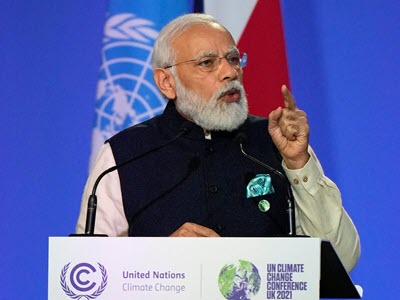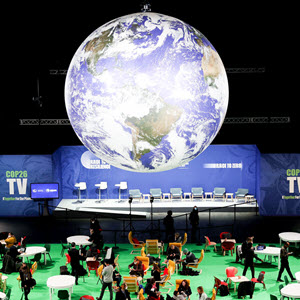Roundtable from Beyond COP26: Regional Cooperation for Climate
Opportunities for India in the Coming Decade of Climate Action
This essay by Subrata Chakrabarty is part of the roundtable Beyond COP26: Regional Cooperation on Climate Change.
At COP26, India surprised the world with the announcement of a net-zero target by 2070. India also announced a few interim targets that include non-fossil-fuel-based electricity capacity, renewable energy (RE) targets, absolute emission reduction targets, and enhancement of carbon intensity reduction targets, all by 2030.[1] The interim announcements will have significant implications that will extend beyond the power sector. The realization of interim targets, however, will depend on how India plans to address a few crucial issues at hand.
IMPLICATIONS OF RE TARGETS
Integrating variable power would require grid flexibility. Currently, India’s RE installed capacity stands at just over 150 gigawatts (GW), and it contributed to achieving one of India’s nationally determined contribution (NDC) targets.[2] A few RE programs introduced by the government fueled this progress, such as grid-connected rooftop solar photovoltaic (PV) power projects, grid-connected solar PV power projects by government producers under the Central Public Sector Undertaking (CPSU) scheme phase two, the Solar Park scheme, procurement-based incentives under the PM-KUSUM scheme, and the Green Energy Corridor. India is likely to reach 817 GW of total installed capacity by 2030, with more than 50% of that total likely to be met through RE sources such as solar and wind.[3] This would require paced augmentation of the grid infrastructure, including, but not limited, to a responsive grid system, better planning and forecasting of electricity demand, advanced metering systems, regional interconnection and balancing, and a smart grid.[4]
Optimum utilization of the existing generation capacity. India’s electricity demand is set to increase due to rising need of electricity from end-use sectors such as industry, buildings, and transportation.[5] India will need to increase its generation capacity when it cannot meet the growing electricity demand through existing and future plans to add capacity. This will be cost-intensive and calls for optimal utilization of existing generation capacity.[6] Battery storage is obviously seen as a technological option to accommodate variable RE but is best suited for addressing short-term flexibility needs. Besides, India will need to develop and implement the resource adequacy plans and guidelines to ensure a continuous power supply to meet the electricity demand from end users.[7]
Building resilient infrastructure in the power sector. In the recent past, India experienced several extreme weather events that also affected power sector infrastructure. In September 2021, for example, heavy rainfall in the West Midnapore district of West Bengal resulted in flooded substations and some fatalities due to electrocution. Over 100,000 people were without electricity supply for several days.[8] The recent Intergovernmental Panel on Climate Change report emphasizes increased weather events in South Asia, including India—such as a 20% surge in rainfall and prolonged extreme heat and droughts.[9] Preparing for natural disasters will require additional investment and targeted planning that includes understanding the risks in the region and the identification of vulnerable areas.[10]
BEYOND THE POWER SECTOR
The industrial sector is the second-biggest greenhouse gas–emitting sector after electricity generation.[11] Electricity accounted for approximately 14% of India’s industrial energy use in 2020; this share is likely to increase to 39% in a long-term decarbonization scenario.[12] The following suggestions can act as starting points for decarbonizing the industrial sector, with a focus on hard-to-abate industries such as cement, iron and steel, and chemicals.
Accelerate industrial decarbonization through a policy push. At the national level, India does not have a blanket policy or a dedicated strategy to decarbonize the industrial sector. Policies and regulations have played an enabling role in the adoption of decarbonizing strategies in other sectors such as the push for electric vehicles in the transportation sector and energy efficiency measures in industries through Perform, Achieve, and Trade (PAT). The inadequacy of policy signals toward decarbonization prevents the industrial sector from taking bold climate action.[13]
Restructuring industrial electricity pricing. The low share of electricity use in the industry sector is attributed to higher commercial electricity rates, making electricity more expensive than other fuels.[14] Industries need to move toward power markets and open access rather than depending on thermal-based power purchase agreements and grid-supplied electricity. As demand for electricity increases in the open market, more power developers, including RE generators, will be inclined to sell their electricity. This will make commercial electricity competitive while transitioning power procurement to market-based mechanisms that enable low-cost, clean generation.[15] Such interventions, however, would require regulatory support.
DESIGNING STRATEGIES THAT ARE “JUST”
India’s electricity grid is dependent both on fossil fuels (mostly coal) and RE-based generation. In response to the COP26 announcements, India will have to develop and implement a transition strategy. Such a strategy needs to include elements such as sequencing the phaseout process, understanding the real cost of fossil fuels (such as local health, environmental, and climate consequences), and involving relevant stakeholders. To ensure that the strategy does not necessitate climate migration from coal-dependent districts in states like Jharkhand, Chhattisgarh, and Odisha, the strategy will also need to go beyond the technical aspects to include policies and programs that ensure the jobs and livelihoods of workers in the fossil fuel industry. For this to happen, it will be crucial to understand the nature of dependency and risks associated with the transition across the fossil fuel value chain, to identify regional economic diversification options and alternative sectors that align with local priorities.[16]
CONCLUSIONS
India’s interim targets announced at COP26 and its long-term vision to achieve its net-zero goal by 2070 require a coordinated approach among all relevant stakeholders. These include line ministries at the national level and subnational departments and agencies, nonstate actors, and local communities. Further, delivering on the new targets, and consequently the decarbonization efforts that go hand in hand with transitional strategies from fossil fuel to clean energy, will be contingent on fulfilment of timely and adequate financing from developed economies.
India already has called on the developed economies to provide climate financing of $1 trillion at COP26. Tapping into all forms of domestic, public, and private financing, coupled with harnessing the technological know-how from developed nations, is essential if India is to meet its new targets.
Subrata Chakrabarty is Senior Manager with the Climate Program at WRI India. He is involved in research in thematic areas informing the next round of ambitious climate actions and long-term strategies. He is also involved in various areas of work related to subnational and corporate climate action. Mr. Chakrabarty holds a master’s degree in energy systems from the University of Petroleum and Energy Studies in Dehradun, India.
Note: The views expressed are those of the author.
Endnotes
[1] Shri Narendra Modi, “National Statement by Prime Minister Shri Narendra Modi at COP26 Summit in Glasgow,” Prime Minister’s Office of India, November 1, 2021, https://pib.gov.in/PressReleasePage.aspx?PRID=1768712.
[2] Ministry of New and Renewable Energy (India), “India Achieves Target of 40% Installed Electricity Capacity from Non-Fossil Fuel Sources,” December 2, 2021, https://pib.gov.in/PressReleasePage.aspx?PRID=1777364.
[3] Ministry of Power (India), “Report on Optimal Generation Capacity Mix for 2029–30,” Central Electricity Authority, January 2020, https://cea.nic.in/old/reports/others/planning/irp/Optimal_mix_report_2029-30_FINAL.pdf.
[4] Vibhuti Garg, “Increasing Competition in India’s Transmission Sector: Strengthening the Weakest Link to Achieve India’s Renewable Energy Target,” Institute for Energy Economics and Financial Analysis (IEEFA), February 2020, https://ieefa.org/wp-content/uploads/2020/02/Increasing-Competition-in-India-Transmission-Sector_February-2020.pdf.
[5] “India Energy Outlook 2021,” International Energy Agency (IEA), February 2021, https://www.iea.org/reports/india-energy-outlook-2021.
[6] Rahul Tongia, “Balancing India’s Electricity Grid in 2030: A Detailed Granular Analysis Under Uncertainty,” Centre for Social and Economic Progress (CSEP), September 17, 2021, https://csep.org/blog/balancing-indias-electricity-grid-in-2030-a-detailed-granular-analysis-under-uncertainty.
[7] “Power Ministry Working on Resource Adequacy Plan Guidelines,” Economic Times, December 22, 2021, https://economictimes.indiatimes.com/news/economy/policy/power-ministry-working-on-resource-adequacy-plan-guidelines/articleshow/88438066.cms.
[8] Anshuman Phadikar, “Power Turned Off in Flood Zones in East Midnapore,” Telegraph (India), September 24, 2021, https://www.telegraphindia.com/west-bengal/power-turned-off-in-flood-zones-in-east-midnapore/cid/1832001.
[9] “Regional Factsheet: Asia, Sixth Assessment Report, Working Group I (the Physical Science Basis),” Intergovernmental Panel on Climate Change (IPCC), https://www.ipcc.ch/report/ar6/wg1/downloads/factsheets/IPCC_AR6_WGI_Regional_Fact_Sheet_Asia.pdf; and Mayank Aggarwal and Sahana Ghosh, “IPCC Report Warns India Likely to See More Extreme Weather Events,” Mongabay, August 11, 2021, https://india.mongabay.com/2021/08/ipcc-report-warns-india-likely-to-see-more-extreme-weather-events.
[10] Daljit Singh, “Long-Term Goal-Setting and Planning for Decarbonising the Indian Power Sector: Need for a Coordinated Approach,” CSEP, October 29, 2021, https://csep.org/working-paper/long-term-goal-setting-and-planning-for-decarbonising-the-indian-power-sector-need-for-a-coordinated-approach.
[11] Ministry of Environment, Forest, and Climate Change (India), “India’s Third Biennial Update Report to the United Nations Framework Convention on Climate Change,” February 2021, https://unfccc.int/sites/default/files/resource/INDIA_%20BUR-3_20.02.2021_High.pdf; and Subrata Chakrabarty and Priyal Shah, “Three Ways India Inc Can Accelerate Climate Action,” WRI India, May 20, 2021, https://wri-india.org/blog/three-ways-india-inc-can-accelerate-climate-action.
[12] Data is from the Energy Policy Simulator, https://india.energypolicy.solutions.
[13] “A Spotlight on Decarbonising Heavy Industry in India: Narratives on Iron and Steel, Cement, and Chemicals,” Climate Group, March 22, 2021, https://www.theclimategroup.org/our-work/publications/spotlight-decarbonising-heavy-industry-india-narratives-iron-and-steel-cement.
[14] Vaibhav Chaturvedi, Poonam Nagar Koti, and Anjali Ramakrishnan Chordia, “Pathways towards India’s Nationally Determined Contribution and Mid-Century Strategy,” Energy and Climate Change 2 (2021); and Vaibhav Chaturvedi, “A Vision for a Net-Zero Energy System for India” Energy and Climate Change 2 (2021).
[15] Prasantyh Regy et al., “Turning Around the Power Distribution Sector: Learnings and Best Practices from Reforms,” Niti Aayog, RMI, and RMI India, August 2021, https://www.niti.gov.in/sites/default/files/2021-08/Electricity-Distribution-Report_030821.pdf.
[16] Sandeep Pai et al., “Understanding Just Transitions in Coal-Dependent Communities: Case Studies from Mpumalanga, South Africa, and Jharkhand, India,” Center for Strategic and International Studies, October 2021, https://cif-jti.assyst-uc.com/wp-content/uploads/2021/10/CoalDependentCommunities_Report.pdf.



